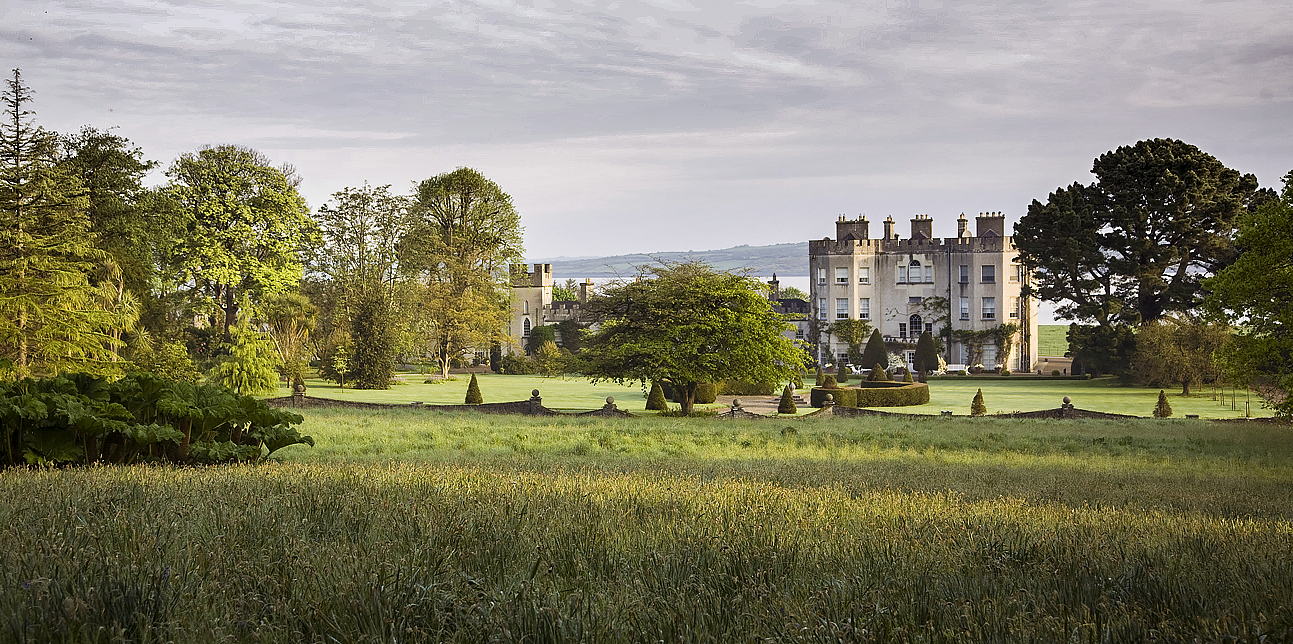Glin Castle
Glin Castle, seat of the FitzGerald family, hereditary Knights of Glin, looks out over the estuary of the River Shannon, Ireland’s longest river, to the hills of County Clare. Nearby is Glin village, a charming hamlet near the border between County Limerick and the neighbouring ‘Kingdom’ of County Kerry. The Glin demesne makes a fine sight from boats upon the river, and especially from ships passing upstream on their way to Limerick and Foynes, with the castle and its outbuilding surrounded by trees and gardens, and encircled by a band of wooded hills.
The FitzGeralds of Glin are a branch of the family of the earls of Desmond, who were granted lands in County Limerick in the 14th century. Originally there were three of these famous hereditary knights in mediaeval Ireland, all FitzGeralds by name or descent. The Knight of Glin (the name really means Glen or Valley) died with the 29th holder, the Knights of Kerry have not used their title since the holder became a baronet and the last acknowledged White Knight, Maurice Oge Fitzgibbon, was killed in a skirmish in 1611.
In 1600 Sir George Carew besieged Glin and the family estates were confiscated. Before the siege he had captured the Knight’s son, tied him to the mouth of a cannon and threatened to blow him to pieces unless the castle surrendered. The Knight replied that he was still extremely virile and that his wife would have no difficulty in producing another heir. Sir George took no further action.
The lands were restored in 1615 and, by the late seventeenth century, the family had moved into a thatched long-house, now the attached wing of the present castle. This must have been further extended in the early 18th century with the addition of some double-height rooms, otherwise the full-length portrait of John FitzGerald could never have fitted into the house. A famous duellist, John is depicted being handed a challenge in a painting now hanging in the hall.
The next phase of building was undertaken after his nephew, Colonel John Fitzgerald, married a wealthy heiress Margaretta Mary Fraunceis Gwynne, of Forde Abbey in Dorset and Combe Florey in Somerset. The rustic house at Glin must have seemed a far cry from the superb Stuart interiors of Forde, with its saloon hung with magnificent Mortlake tapestries after Raphael. Clearly she required a more commodious residence.
Her husband had inherited a sea of debts from his rackety uncles, so Margaretta’s fortune paid for the building work and her family arms are impaled with his on the elaborate neo-Classical hall ceiling. The plasterwork symbolises the spirit of the age with military trophies, shields sprouting shamrocks and plaques representing Peace, Justice and War. This ceiling, in the style of James Wyatt, dates from the 1790s.
Beyond is the finest feature of the house, the double-ramped bifurcated staircase.The drawing room and library were also part of this extension. The library has a superbly crafted broken-pediment bookcase, with a door concealed behind the oval trellis.
These sophisticated rooms seem at odds with earlier Knights; wild, horse-loving smugglers, famous for debt and debauchery. While Margaretta’s money was insufficient to complete the work it produced a superb house, with the ground floor treated as a piano nobile and two upper storeys. The two main facades have full height three-bay bows at either end, semi-circular at the entrance and half hexagonal at the garden front. It is also typically Irish in that the plain exterior is a perfect foil for the richness of the interior.
She soon returned to the protection of her half brother at Forde and the household furniture, library and “a superb service of Indian china” (though not the pictures or silver) were sold to pay her husband’s debts when he died in 1812.
Their son, John Fraunceis, was an only child, which enabled the estate to survive until his majority. He restored the family fortunes by successful gambling and further land sales. He built three Gothic lodges, the walled garden and the battlemented farmyard, he further landscaped the park and hid the newly built road along the River Shannon beneath a massive ha-ha (a ditch with a retaining wall).
In 1816, Nash’s pupil James Pain built the new church beside the entrance. He probably gingered-up the house with mullioned windows and battlements at the same time so that the house became known as Glin Castle once again. Money was scarce in Victorian times, which may have been a blessing in disguise for there were few 19th century ‘improvements’ to blight the house’s character.
When Desmond FitzGerald and his wife Veronica came to Glin in the 1930s the castle was dilapidated, largely because his father was an invalid. Desmond also had poor health and, after his death, Victoria married the Canadian magnate Ray Milner, and together they put the place to rights.
Desmond’s son, another Desmond, the 29th and ultimate Knight of Glin, was a connoisseur and art historian of international renown. He restored the house and wing, and decorated them with his splendid collection of Irish furniture and paintings. Today, Glin Castle is the home of his wife Olda and their children and grandchildren, and entertains people from all over the world.
Address & Contact
Glin Castle, Glin, Limerickt: +353 68 34173
Available as a Film Location
Houses and Garden
Individual Garden Visitors
Culture and Education
Concerts, Plays or Recitals
Educational Visits
Accommodation and Short Breaks
Whole House Rentals
Events
Meetings or receptions


